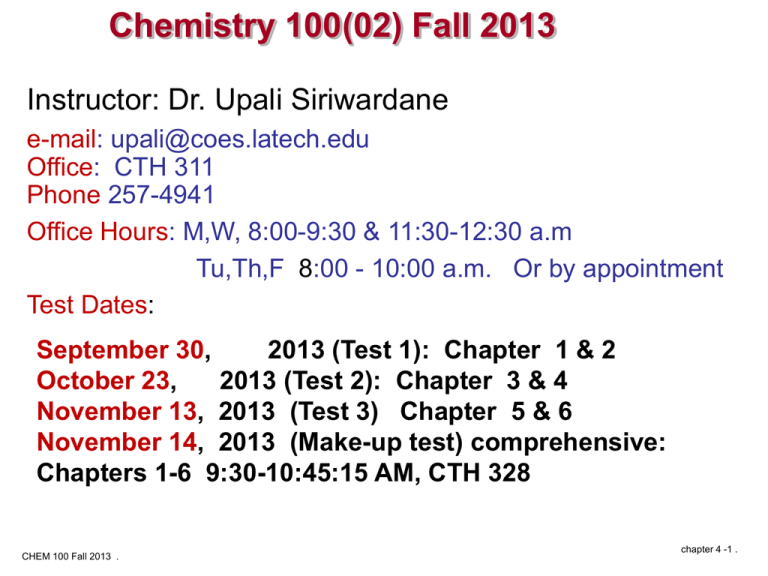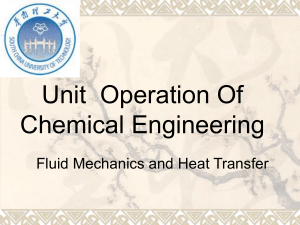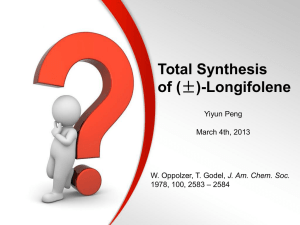
Chemistry 100(02) Fall 2013
Instructor: Dr. Upali Siriwardane
e-mail: upali@coes.latech.edu
Office: CTH 311
Phone 257-4941
Office Hours: M,W, 8:00-9:30 & 11:30-12:30 a.m
Tu,Th,F 8:00 - 10:00 a.m. Or by appointment
Test Dates:
September 30,
2013 (Test 1): Chapter 1 & 2
October 23,
2013 (Test 2): Chapter 3 & 4
November 13, 2013 (Test 3) Chapter 5 & 6
November 14, 2013 (Make-up test) comprehensive:
Chapters 1-6 9:30-10:45:15 AM, CTH 328
CHEM 100 Fall 2013 .
chapter 4 -1 .
Text Book & Resources
REQUIRED :
Textbook: Principles of Chemistry: A Molecular Approach, 2nd
Edition-Nivaldo J. Tro - Pearson Prentice Hall and also purchase
the Mastering Chemistry
Group Homework, Slides and Exam review guides and sample
exam questions are available online: http://moodle.latech.edu/
and follow the course information links.
OPTIONAL :
Study Guide: Chemistry: A Molecular Approach, 2nd EditionNivaldo J. Tro 2nd Edition
Student Solutions Manual: Chemistry: A Molecular Approach, 2nd
Edition-Nivaldo J. Tro 2nd
CHEM 100 Fall 2013 .
chapter 4 -2 .
Chapter 4. Chemical Quantities and Aqueous Reactions
4.1 Global Warming and the Combustion of Fossil Fuels…………………. 127
4.2 Reaction Stoichiometry: How Much Carbon Dioxide?......................... 128
4.3 Limiting Reactant, Theoretical Yield, and Percent Yield………………. 133
4.4 Solution Concentration and Solution Stoichiometry………………….. 140
4.5 Types of Aqueous Solutions and Solubility…………………………….. 146
4.6 Precipitation Reactions………………………………………………….. 150
4.7 Representing Aqueous Reactions: Molecular, Ionic, and Complete Ionic
Equations…………………………………………………………………........ 153
4.8 Acid–Base and Gas-Evolution Reactions……………………………..... 155
4.9 Oxidation–Reduction Reactions…………………………………………. 162
CHEM 100 Fall 2013 .
chapter 4 -3 .
Chapter 4. Chemical Quantities and Aqueous Reactions
•Solution Chemistry
•Solution Concentration
•Common types of chemical
reactions
•Types of chemical equations
•Write molecular equation
•Write complete ionic equation
•Write a net ionic equation
•Solubilities of chemical compounds
CHEM 100 Fall 2013 .
•Precipitation Reactions
•Solubility Rules
•Acid–Base and Gas-Evolution
Reactions
•Neutralization reactions
•Common acids and bases
•Oxidation–Reduction Reactions
•Stoichiometry in Solution
Reactions
chapter 4 -4 .
Why Solution Chemistry?
Collisions of reactants decides the rates of a
reactions
Why not gaseous Reactions?
In Gases: Very fast Reactions (burning natural gas)
Solution reactions are manageable!
Liquids:
Fast Reactions (precipitation of AgCl)
Water is the most common solvent
Why not solid Reactions?
Solids: Very slow Reactions (making ceramics)
CHEM 100 Fall 2013 .
chapter 4 -5 .
1) Identify the gas phase, solution (liquid) and
solid phase reactions.
a) O2(g) + 2 H2(g) 2 H2O(l):
b) AgNO3(aq) + NaCl(aq) AgCl(s) insoluble salt + NaNO3(aq)
c) 2C4H10(g) + 13O2(g) 8CO2(g) + 10H2O(g):
d) 2 Al (s) + Fe2O3 (s) 2 Fe(s) + Al2O3(s):
CHEM 100 Fall 2013 .
chapter 4 -6 .
What is a Solution?
• A solution: A homogeneous mixture of
two or more components.
Sugar in water
Oxygen in water
Air
Dental fillings
Saline
CHEM 100 Fall 2013 .
chapter 4 -7 .
Dissolution of (a) Ionic and (b) Molecular Compounds
CHEM 100 Fall 2013 .
chapter 4 -8 .
Components of a Solution
Solute
• substance that is present in smallest
quantity
• dissolved substance(s)
• can be either a gas, a liquid, or a solid
• one or more present in a solution
Solvent
• substance present in largest quantity
• only one per solution
• water in aqueous solutions
CHEM 100 Fall 2013 .
chapter 4 -9 .
Concentration Units
mol 𝐬𝐨𝐥𝐮𝐭𝐞
a) Molarity (M)
M = Liters of solution
b) b) Molality (m)
m=
mol solute
kg of solvent
c) c) Mole fraction (a)
mol 𝐬olute
a = mol (𝐬𝐨𝐥𝐮𝐭𝐞)+mol (𝐬𝐨𝐥𝐯𝐞𝐧𝐭)
d) Mass percent (% weight)
w/w % =
e) Volume percent (% volume)
f) "Proof"
𝐠 𝐬𝐨𝐥𝐮𝐭𝐞 +𝐠(𝐬𝐨𝐥𝐯𝐞𝐧𝐭)
v/v % = 𝐯
x 100
v (𝐬olute)
𝐬𝐨𝐥𝐮𝐭𝐞 + 𝐯(𝐬𝐨𝐥𝐯𝐞𝐧𝐭)
x 100
Proof = (w/w %) x 2
g) ppm and ppb
CHEM 100 Fall 2013 .
g (𝐬olute)
g (𝐬olute)
ppm (w/w) = 𝐠 (𝐬𝐨𝐥𝐮𝐭𝐢𝐨𝐧) x 106
g (𝐬olute)
ppb (w/w) = 𝐠 (𝐬𝐨𝐥𝐮𝐭𝐢𝐨𝐧) x 109
g (𝐬olute)
ppm (w/v) = 𝐋 (𝐬𝐨𝐥𝐮𝐭𝐢𝐨𝐧) x 106
chapter 4 -10 .
Examples
Calculate the molarity of a solution prepared by dissolving
200.0 g of K2SO4 in enough water to make 500.0 mL
solution.
moles of solute
Molarity(M) = ---------------------Liters of solution
CHEM 100 Fall 2013 .
chapter 4 -11 .
Preparing 1.00 L of a 1.00 M NaCl Solution
from a Solid Solute
CHEM 100 Fall 2013 .
chapter 4 -12 .
2) Molarity Calculations: Calculate the molarity of a solution
prepared by dissolving 200.0 g of K2SO4 in enough water to
make 500.0 mL solution.
CHEM 100 Fall 2013 .
chapter 4 -13 .
solute = K2SO4; F.W. = 174.27 g/mol; mass= 200g
moles of K2SO4 = ?
200 g /174.27 g K2SO4
= 1.148 mol K2SO4
500.0 mL = ?
Liters of solution = 0.5 L
Molarity?
1.148 mol K2SO4
Molarity of K2SO4 sol. = -----------------------0.5 Liters of solution
= 2.30 mole/Liter = 2.30 M (M = moles/liters)
CHEM 100 Fall 2013 .
chapter 4 -14 .
How do you calculate moles of
substances in solutions
• Use concentration of solution to convert L or
mL of solution in to moles
• What is concentration of a solution?
• The relative amounts of solute and solvent
• There are so many ways to show amount: g,
mole, equivalents, volume
CHEM 100 Fall 2013 .
chapter 4 -15 .
3) Gram-mol-M conversions: How many grams of KNO3
are contained in 500 mL of a 0.500 M solution of potassium
nitrate?
CHEM 100 Fall 2013 .
chapter 4 -16 .
Dilution Problems
Why we dilute solutions?
Preparing solutions by adding water to
concentrated solutions
moles before = moles after
MiVi = MfVf
Mi
Vi
Mf
Vf
CHEM 100 Fall 2013 .
= initial molarity
= initial volume
=
final molarity
=
final molarity
chapter 4 -17 .
Solution Preparation by Dilution
CHEM 100 Fall 2013 .
chapter 4 -18 .
4) Dilution problems: How many mL of 2.00 M solution of nitric
acid, HNO3 are required with water to make a 250 mL of 1.50 M
HNO3 acid solution?
CHEM 100 Fall 2013 .
chapter 4 -19 .
Ion Concentrations in Solutions
5) What is concentration of Cl- in 0.4 M MgCl2
aqueous solution if MgCl2 a strong electrolyte?
CHEM 100 Fall 2013 .
chapter 4 -20 .
Types of Chemical Reactions
Based on driving force
a) Precipitation Reactions (insoluble salt)
b) Acid-base Reactions (neutralization)
c) Gas-forming Reactions (escaping gas)
d)Oxidation-reduction (REDOX)Reactions
(electron transfer)
CHEM 100 Fall 2013 .
chapter 4 -21 .
6) Classify following solution reactions as precipitation, acid/base
and redox reactions.
a) KOH (aq)
+ HNO3(aq)
-->
KNO3(aq) + H2O(l):
b) HCl(aq) + NaHCO3(aq)
-->
c) Fe(s) + Cu(NO3)2(aq)
--> Fe(NO3)2(aq) + Cu(s)
d) AgNO3(aq) + NaCl(aq)
--> AgCl(s) + NaNO3(aq)
e) NaOH(aq)
CHEM 100 Fall 2013 .
NaCl(aq) + H2O(l) + CO2(g):
+ HC2H3O2(aq) --> NaC2H3O2(aq)
+ H2O(l)
chapter 4 -22 .
Some acids, bases and their salts
Acid
Name
Acetic acid
Hydrogen chloride
Nitric acid
Phosphoric acid
Sulfuric acid
•
Base
Name
Sodium hydroxide
Barium oxide
Sodium oxide
Ammonia
CHEM 100 Fall 2013 .
Sodium salt
Name
Formula
HC2H3O2
HCl
HNO3
H3PO4
H2SO4
Sodium acetate
Sodium chloride
Sodium nitrate
Sodium phosphate
Sodium sulfate
NaC2H3O2
NaCl
NaNO3
Na3PO4
Na2SO4
Chloride salt
Formula
NaOH
BaO
Na2O
NH3
Name
Sodium chloride
Barium chloride
Sodium chloride
Ammonium chloride
Formula
NaCl
BaCl2
NaCl
NH4Cl
Formula
chapter 4 -23 .
7) Identify molecular compounds, acids, bases, and salts among the following:
a) AgNO3
b) NaCl
g) NaNO3
h ) CH3OH
l) KNO3
CHEM 100 Fall 2013 .
m) HNO3
c) C6H12O6 d) H3PO4
e) NaOH
f) HCl,
i) CH3COOH j) H2SO4 k) HC2H3O2
n) MgO
o) K2O
p) SO3
chapter 4 -24 .
How do find precursor Acid and base of a Salt
Acid (A) + Base(B) = Salt + water (H2O)
HA +
BOH = BA + H2O
E.g. LiNO3
B (Li)
A (NO3)
OH
H
BOH(LiOH) HA(HNO3)
CHEM 100 Fall 2013 .
chapter 4 -25 .
8) Identify the precursor acid and base for the following salts:
a) AgNO3
b) NaCl
c) NaNO3
d) K2SO4,
e) NaC2H3O2
CHEM 100 Fall 2013 .
chapter 4 -26 .
Types of Chemical Equations
Molecular equation:
Equation with formula, correct stoichiometric coefficients and
physical form written within parenthesis.
Ionic equation:
All the ionic compounds soluble in water are separated into ions
written with their ionic charge and (aq).
Net Ionic equation:
Ionic equation with all spectator ions removed from both sides.
•
CHEM 100 Fall 2013 .
chapter 4 -27 .
Chemical Reaction:
NaCl(aq)+AgNO3(aq)
-->AgCl(s)+ NaNO3(aq)
Molecular equation:
NaCl (aq) + AgNO3 (aq) --> AgCl (s) + NaNO3 (aq)
Ionic Equation:
Na+ (aq) + Cl-(aq) + Ag+ (aq) + NO3-(aq)
--> AgCl(s) + Na+(aq) + NO3- (aq)
Spectator Ions:
Na+ (aq) and NO-3 (aq)
Net Ionic Equation:
Cl- (aq) + Ag+ (aq) --> AgCl (s)
CHEM 100 Fall 2013 .
chapter 4 -28 .
Spectator Ions
Ions appearing on both side of an ionic equation.
We need to look at the ionic equation:
Ionic Equation:
Na+ (aq) + Cl-(aq) + Ag + (aq) + NO3-(aq) --> AgCl(s) + Na +(aq) + NO3- (aq)
CHEM 100 Fall 2013 .
chapter 4 -29 .
Ionic equations
When ionic substances dissolve in water, they
dissociate into ions.
H2O
AgNO3
KCl
H2O
Ag+ + NO3K+ + Cl-
When a reaction occurs, only some of the ions
are actually involved in the reaction.
Ag+ + NO3- + K+ + ClCHEM 100 Fall 2013 .
AgCl(s) + K+ + NO3chapter 4 -30 .
Write molecular equation etc…
9) Write molecular, total ionic, and net ionic reactions for the
following solution reactions
a) Ba(NO3)2 (aq) + Na2SO4(aq) ----> BaSO4 (s) + 2NaNO3 (aq)
Molecular equation:
Total ionic equation:
Spectator Ions:
Net ionic equation:
CHEM 100 Fall 2013 .
chapter 4 -31 .
9) Write molecular, total ionic, and net ionic reactions for the
following solution reactions
b) HCl(aq) + NaOH(aq) ----> NaCl(aq) + H2O(l)
Molecular equation:
Total ionic equation:
Spectator Ions:
Net ionic equation:
CHEM 100 Fall 2013 .
chapter 4 -32 .
9) Write molecular, total ionic, and net ionic reactions for the
following solution reactions
c) NaOH(aq) + HC2H3O2(l)
----> NaC2H3O2(aq) + H2O(l)
Molecular equation:
Total ionic equation:
Spectator Ions:
Net ionic equation:
CHEM 100 Fall 2013 .
chapter 4 -33 .
Precipitation reactions
They are double displacement reactions of ionic compounds
where an insoluble salt is formed when two aqueous salt
solutions are mixed.
a) Ba(NO3)2 (aq) + Na2SO4(aq) ----> BaSO4 (s) + 2NaNO3 (aq)
a) NaCl(aq)+AgNO3(aq)
CHEM 100 Fall 2013 .
-->AgCl(s)+ NaNO3(aq)
chapter 4 -34 .
CHEM 100 Fall 2013 .
chapter 4 -35 .
Precipitation of Barium Sulfate
Double Displacement:
Formation of insoluble salt is the diving force
BaCl2(aq) + Na2SO4(aq) 2NaCl(aq) + BaSO4(s)
precipitate
CHEM 100 Fall 2013 .
chapter 4 -36 .
Precipitation of Silver Chloride
Formation of insoluble salt is the diving force
AgNO3 (aq) + NaCl AgCl(s) + NaNO3 (aq)
precipitate
CHEM 100 Fall 2013 .
chapter 4 -37 .
Solubility rules for ionic compounds
a) All acids are soluble.
b) All Na+, K+ and NH4+ salts are soluble.
c) All nitrate and acetate salts are soluble.
d) All chlorides except AgCl and Hg2Cl2 PbCl2 are soluble.
e) All sulfates are soluble except PbSO4, Hg2SO4, SrSO4 and
BaSO4.
f) All sulfides are insoluble except those of the Group IA (1),
IIA (2) and ammonium sulfide.
g) All hydroxides are insoluble except those of the group
IA(1) and IIA Ba(OH)2. Sr(OH)2 and Ca(OH)2
CHEM 100 Fall 2013 .
chapter 4 -38 .
Illustration of Some
Solubility Rules
CHEM 100 Fall 2013 .
chapter 4 -39 .
10) Which of the following salts (ionic compounds)
is soluble/insoluble in water?
a) NaCl
b) Li2CO3
e) NH4NO3
f) Ca(NO3)2 g) CaSO4
i) Mg3(PO4)2
j) MnO2
m) CH3CO2Na n) Cu(OH)2
CHEM 100 Fall 2013 .
c) AgCl
d) PbBr2
h) CaCO3
k) Al(OH)3
l) BaSO4
o) Fe(ClO4)2
chapter 4 -40 .
Precipitation or Not
• MgI2 + NaNO3= 2 NaI
+ Mg(NO3)2
• Ba(NO3)2+Na2SO4= BaSO4 + 2 NaNO3
• AgCl +NaNO3
CHEM 100 Fall 2013 .
= AgNO3 + NaCl
chapter 4 -41 .
Acid/base Reactions
Acid
• substance that donates H+ ions to solution
• sour-tasting substances
• substances whose aqueous solutions are capable of
turning blue litmus indicators red
• dissolves certain metals to form salts
• react with bases or alkalis to form salts
Base
•
•
•
•
•
substance that donates a OH-1 ion to solution
hydroxides and oxides of metals
bitter tasting, slippery solutions
turn litmus blue
react with acids to form salts
CHEM 100 Fall 2013 .
chapter 4 -42 .
Neutralization Reactions
Formation of water is the diving force
acid + base “salt” + water
HCl + NaOH NaCl + H2O
H2SO4 + 2KOH K2SO4 + 2H2O
Salt
•
•
•
•
Substances produced by the reaction of an acid with a base
Characterized by ionic bonds and high melting points
Electrical conductivity when melted or when in solution
Has a crystalline structure when in the solid state
CHEM 100 Fall 2013 .
chapter 4 -43 .
Ionization of Acids in Water
CHEM 100 Fall 2013 .
chapter 4 -44 .
Titrations
CHEM 100 Fall 2013 .
chapter 4 -45 .
Ionic Equations Strong Acid/base
Molecular Equation:
HCl(aq) + NaOH(aq) ----> NaCl(aq) + H2O(l)
Total Ionic Equation:
H+ + Cl-1 + Na+ + OH-1 Na+ +Cl-1 + H2O
Net Ionic Equation:
H+ + OH-1 H2O
NaOH(aq) + HC2H3O2(aq) -----> NaC2H3O2(aq) + H2O(l)
Na+(aq) + OH -(aq) + HC2H3O2(aq) -----> Na+(aq) +C2H3O2-(aq) + H2O(l)
HC2H3O2(aq) + OH-1 C2H3O2-(aq) + H2O
CHEM 100 Fall 2013 .
chapter 4 -46 .
Common Acids and Bases
CHEM 100 Fall 2013 .
chapter 4 -47 .
Gas-Forming Exchange Reaction: CO2, SO2, H2S
Escape of a gas is the diving force
CHEM 100 Fall 2013 .
chapter 4 -48 .
Gas-Forming Reactions
Metal carbonates + acid CO2(g) + salt + water
Na2CO3(aq) + 2HCl(aq) H2O(l) + CO2(g) + 2 NaCl(aq)
Net ionic:
CO32- + 2 H+ H2O(l) + CO2(g)
CaCO3(s) + 2 HCl(aq) CO2(g) + H2O(l) + CaCl2(aq)
Net ionic: CaCO3(s) + 2 H+ CO2(g) + H2O(l) + Ca2+
Metal (s) + acid Gas + salt
Mg(s) + 2 HCl(aq) H2(g) + MgCl2(aq)
Net ionic:
CHEM 100 Fall 2013 .
Mg(s) + 2 H+ H2(g) + Mg2+
chapter 4 -49 .
Reaction of Metal Carbonates with Acids
Molecular Equation:
CaCO3(s) + 2HCl(aq) CaCl2(aq) + H2CO3(aq)
H2CO3(aq) H2O + CO2(g)
Total Ionic Equation:
CaCO3(s) + 2H+ + 2Cl-1 Ca+2 + 2Cl-1 + H2O + CO2(g)
Net Ionic Equation:
CaCO3(s) + 2H+ Ca+2 + H2O + CO2(g)
CHEM 100 Fall 2013 .
chapter 4 -50 .
Reaction of Metal Carbonates with Acids
Alka-Seltzer
NaHCO3(aq) + HCl(aq) NaCl(aq) + H2O + CO2(g)
Net Ionic Equation:
HCO3-1 + 2H+ H2O + CO2(g)
Tums
CaCO3(s) + 2HCl(aq) CaCl2(aq) + H2O + CO2(g)
Net Ionic Equation:
CO3-2 + 2H+ H2O + CO2(g)
CHEM 100 Fall 2013 .
chapter 4 -51 .
Reaction of Metal Sulfites with Acids
Molecular Equation:
CaSO3(s) + 2HCl(aq) CaCl2(aq) + H2SO3(aq)
H2SO3(aq) H2O + SO2(g)
Total Ionic Equation:
CaSO3(s) + 2H+ + 2Cl-1 Ca+2 + 2Cl-1 + H2O + SO2(g)
Net Ionic Equation:
CaSO3(s) + 2H+ Ca+2 + H2O + SO2(g)
CHEM 100 Fall 2013 .
chapter 4 -52 .
Reaction of Metal Sulfides with Acids
Molecular Equation:
Na2S(aq) + 2HCl(aq) 2NaCl(aq) + H2S(g)
Total Ionic Equation:
2Na+ + S-2 + 2H+ + 2Cl-1 2Na+ + 2Cl-1 + H2S(g)
Net Ionic Equation:
S-2 + 2H+ H2S(g)
CHEM 100 Fall 2013 .
chapter 4 -53 .
Oxidation–Reduction Reactions
Electrons are transferred from one compound to the
other resulting in a chemical change.
E.g. Zn(s) + 2HCl(aq) ---> ZnCl2(aq) + H2(g)
Ox # 0
+1, -1
2+, -1
+1
includes Single Replacement Reactions
Oxidation –loss of electrons
Reduction – gain of electrons
oxidizing agent – substance that causes oxidation
reducing agent – substance that cause reduction
CHEM 100 Fall 2013 .
chapter 4 -54 .
Ionic Equations Weak
Acid/base
Molecular Equation:
NaOH(aq) + HC2H3O2(aq) -----> NaC2H3O2 (aq) + H2O(l)
Total Ionic Equation:
Na+(aq) + OH - (aq) + HC2H3O2(aq) ----> Na+(aq) + C2H3O2 -(aq) + H2O(l)
Net Ionic Equation:
HC2H3O2 (aq) + OH- C2H3O2 - (aq) + H2O
CHEM 100 Fall 2013 .
chapter 4 -55 .
Acid/base Ionic Equations
Molecular Equation:
H2SO4 + 2KOH K2SO4 + 2H2O
Total Ionic Equation:
2H+ + SO4-2 + 2Na+ + 2OH-1 2Na+ +2Cl-1 + 2H2O
Net Ionic Equation:
2H+ + 2OH-1 2H2O
CHEM 100 Fall 2013 .
chapter 4 -56 .
Oxidation-Reduction (Redox) Reactions
Electrons are transferred from one compound to the other
resulting in a chemical change.
E.g. Zn(s) + 2HCl(aq) ---> ZnCl2(aq) + H2(g)
Ox # 0
+1, -1
2+, -1
+1
includes Single Replacement Reactions
Oxidation –loss of electrons
Reduction – gain of electrons
oxidizing agent – substance that causes oxidation
reducing agent – substance that cause reduction
CHEM 100 Fall 2013 .
chapter 4 -57 .
Oxidation-Reduction Reactions
CHEM 100 Fall 2013 .
chapter 4 -58 .
CHEM 100 Fall 2013 .
chapter 4 -59 .
CHEM 100 Fall 2013 .
chapter 4 -60 .
Single replacement reactions
If various metals are in water, we observe that some are
more reactive than others.
2Na (s) + 2H2O (l)
Ca (s) + 2H2O (l)
Mg (s) + H2O (l)
2NaOH (aq) + H2 (g) (fast)
Ca(OH)2 (s) + H2 (g) (slow)
no reaction
This indicates that the order of reactivity of these metals
towards water is
Na > Ca > Mg
We can show the reactivity of metals towards water and
acids using an activity series.
CHEM 100 Fall 2013 .
chapter 4 -61 .
Recognizing Redox Reactions
CHEM 100 Fall 2013 .
chapter 4 -62 .
Oxidation number or State
A number assigned to a atom in compounds, ions
and polyatomic ions to show the number of
electrons relative to an atom in the element.
CHEM 100 Fall 2013 .
chapter 4 -63 .
Copper Oxide and Hydrogen Gas
CHEM 100 Fall 2013 .
chapter 4 -64 .
Activation
Series of
Metals
CHEM 100 Fall 2013 .
chapter 4 -65 .
Rules for Assigning Ox #
a)
Oxidation number of atoms in an element
is zero (0). e.g. O2
b) Monoatomic ions: Ox # equal to charge.
E.g. Na+, Ox # = +1
c) Sum of the oxidation numbers in an element, compound is equal to
zero. Sum of the oxidation numbers in an ion, cation or anion is equal
to the ionic charge
d) As a rule ONs of H =+1, and O=-2 almost most of the time.
The group number in the periodic table could be used for main group
elements (p and s blocks). d and f block elements show variable ONs
E.g. Fe shows either +3 or +2.
CHEM 100 Fall 2013 .
chapter 4 -66 .
Oxidation State
What is the oxidation state of Cl in HClO4?
• H +1
• O -2
• neutral compound, thus sum equals zero
• 4O 4 -2 = -8
• H 1 +1 = +1
• 0 = +1 + (y) + (-8)
y = +7
CHEM 100 Fall 2013 .
chapter 4 -67 .
Oxidation State
What is the oxidation state of S in H2SO4?
• H +1
• O -2
• neutral compound, thus sum equals
zero
• 4O 4 -2 = -8
• 2H 2 +1 = +2
• 0 = +2 + (x) + (-8)
x = +6
CHEM 100 Fall 2013 .
chapter 4 -68 .
Assigning the Oxidation State
11) Assign the oxidation states to each atom in
a) NaCl:
b) O2:
c) CBr4:
d) S8:
e) MnO2 :
f) KMnO4 :
g) K2Cr2O7 :
CHEM 100 Fall 2013 .
chapter 4 -69 .
Which of the following reactions
are redox?
a) NaCl + AgNO3 ----> AgCl + NaNO3
b) NaOH + HCl
----> NaCl + H2O
c) Zn + 2HCl
----> ZnCl2 + H2
d) 2Cr + 6HCl
----> 2CrCl3 + 3H2
e) MnO2 + 4HBr ----> Br2 + MnBr2 + 2H2O
CHEM 100 Fall 2013 .
chapter 4 -70 .
Redox Half-Reactions
•
Redox reactions MUST be charge and mass balanced!
•
Balancing redox reactions:
– Note the environment that the reaction is occurring in (neutral, acidic,
basic).
– Split the redox reaction into two separate half-reactions.
• Determine which species is being oxidized and which is being
reduced using oxidation states.
» The oxidation half-reaction has electrons as products.
» The reduction half-reaction has electrons as reactants.
– Mass and charge balance each half-reaction.
• Mass balancing
• Charge balancing
CHEM 100 Fall 2013 .
chapter 4 -71 .
Half Redox Reactions
two half-reactions in a redox reaction: one where the oxidation is
talking place and the other where reduction is taking place.
E.g.
2 Na + Cl2 ----> 2NaCl
ON
0
0
+1 -1
Oxidation Na ----> Na+ + e- ;
Na
increase ON, 0 ----> +1
Reduction
Cl2 + 2e- ----> 2Cl- ;
Cl decrease ON, 0
---->
-1
CHEM 100 Fall 2013 .
chapter 4 -72 .
Redox Half-Reactions
•
Mass and charge balance each half-reaction.
•
Mass balancing
• Balance your metal then nonmetal elements.
• Balance your H next.
• Balance you O last.
– Environment concerns, specifically acidic and basic environments
• Acidic
– Balance H as H+.
– Balance O as water, H2O,
• Basic
– Balance H as H+.
– Balance O as OH-.
– Counterbalance H+ with OH- to make H2O.
•
– Charge balancing
• Use oxidation states to determine number of electrons transferred.
» The oxidation half-reaction has electrons as products.
» The reduction half-reaction has electrons as reactants.
Add the two half-reactions and simplify.
CHEM 100 Fall 2013 .
chapter 4 -73 .
Separating Half Reactions
a) Zn + 2HCl
----> ZnCl2 + H2
b) MnO2+4HBr----> Br2 + MnBr2 + 2H2O
c) 10K + 2KNO3
CHEM 100 Fall 2013 .
----> N2 + 6K2O
chapter 4 -74 .
12) Identify the reducing and oxidizing agent (reactants) in the following
reactions
a)
Reaction:
Oxidation number:
Reducing agent:
Cu(s) +
AgNO3(aq)
Cu =
Ag = N= O =
---> Ag(s) + Cu(NO3)2(aq)
Ag =
Cu= N= O=
Oxidizing agent:
b)
Reaction:
Oxidation number:
Reducing agent:
Fe(s) + Cu(NO3)2(aq )
Fe =
Cu = N= O =
---> Fe(NO3)2(aq) + Cu(s)
Fe= N= O=
Cu=
Oxidizing agent:
c
Reaction:
Oxidation number:
Reducing agent:
Ca(s)
+ H2O(l) --->
Ca =
H=
O=
Ca(OH)2(aq)
Ca =
O=
+ H2(g)
H=
H=
Oxidizing agent:
CHEM 100 Fall 2013 .
chapter 4 -75 .
Activation Series of Metals
• metals higher in series react with
compounds of those below
• metals become less reactive to water top
to bottom
• metals become less able to displace H2
from acids top to bottom
CHEM 100 Fall 2013 .
chapter 4 -76 .
Activity series of metals various metals in HCl
Iron
CHEM 100 Fall 2013 .
Zinc
Magnesium
chapter 4 -77 .
Activation Series of Metals
Zn(s) + CuSO4(aq) ZnSO4(aq) + Cu(s)
Cu(s) + 2AgNO3(aq) Cu(NO3)2(aq) + Ag(s)
Fe(s) + 2HCl(aq) FeCl2(aq) + H2(g)
Zn(s) + 2HBr(aq) ZnBr2(aq) + H2(g)
CHEM 100 Fall 2013 .
chapter 4 -78 .
Stoichiometric Relationships
CHEM 100 Fall 2013 .
chapter 4 -79 .
Solution Stoichiometry
Molarity relates the moles of solute to the liters of
solution.
– It can be used to convert between amount of
reactants and/or products in a chemical reaction.
CHEM 100 Fall 2013 .
chapter 4 -80 .
Stoichiometric calculations of solutions reactions
•
•
•
•
Check whether chemical equation is balanced
get the moles from volume and “M” of solutions
find the limiting reactant
calculate moles of products from the limiting
reactant
• convert moles of the products to grams
• find the actual yield of the reaction
• calculate % yield of the reaction
CHEM 100 Fall 2013 .
chapter 4 -81 .
13) How many mLs of 0.100 M BaCl2 are required to react
completely with 25 mL of 0.200 M Fe2(SO4)3?
3 BaCl2(aq) + Fe2(SO4)3(aq)---> 3 BaSO4(s) + 2 Fe Cl3(aq)
Stoichiometric conversion factors: 3 BaCl2 = 1 Fe2(SO4)3
CHEM 100 Fall 2013 .
chapter 4 -82 .
Calculate the moles of Fe2(SO4)3 :
moles = Molarity x
Liters of solution
0.200 M x 0.025 L = 0.005 mole Fe2(SO4)3
Then convert Fe2(SO4)3 to BaCl2 mole, BaCl2 moles to
liters and liters to mL.
0.005 mole Fe2(SO4)3 ----> BaCl2 moles
0.005 mol Fe2(SO4)3 x 3 = 0.015 BaCl2 moles
moles = Molarity x
Liters of solution
0.015 = 0.100 x Liters
Liters BaCl2 = 0.15L
= 150 mL of BaCl2
CHEM 100 Fall 2013 .
chapter 4 -83 .









